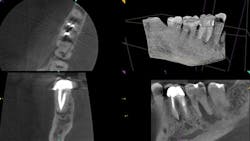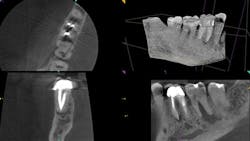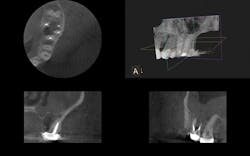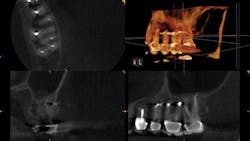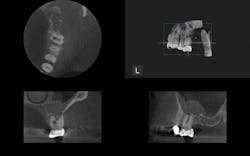'Hello, have you met my CBCT system?'
Using technology to gain and build relationships with referrals
It's an interesting fact that approximately 10% of my practice's patients travel from more than an hour away. I'm fortunate enough to have a dedicated referral base that trusts me to take excellent care of their patients, even with dozens of other specialists between them and me. It's partly due to my years of experience, but also to the advanced technology that helps me practice at my best. In fact, I've found that the technology you use and the quality of your referrals are often related.
READ MORE |Dentistry, the law, and CBCT
As an endodontist, cone-beam computed tomography (CBCT) has become an invaluable part of my practice. The CS 9000 3D from Carestream Dental lets me view the finite detail of root morphology in stunning 3-D detail. It is technology that gives me an edge. General practitioners know that my system allows me to diagnose and treat patients with more success than conventional clinical tests or 2-D radiographs, which would require 33% bone destruction to reveal even a fraction of what I'm able to see with CBCT.1 Over the years, I've used my CBCT system as a way to gain and build relationships with general practitioners, and establish the kind of referral base that happily sends me patients from across the state.
Laying the foundation
• Introduce yourself (and your technology)-When my practice first installed our CBCT system, we wanted to let general practitioners in the area know about the new services we were able to offer. We took advantage of the opportunity by sending a letter to dentists in the surrounding area touting our practice's CBCT capabilities and how it allowed us to diagnose and treat patients like never before. We invited these dentists to learn more by stopping off at our practice, or by referring a patient to us who was in need of diagnosing and imaging capabilities.
• Make friends face-to-face-Nothing replaces an in-person meeting and a firm handshake. When I first joined my practice, I picked up the phone and invited local doctors to lunch. This allowed my colleagues to put my face with a name and gave me the opportunity to speak more in-depth about how I incorporate CBCT into my treatment planning and answer questions about the new technology.
• Add value with an ad-The personal connection of a phone call or friendly letter has served my practice well; however, we do "go big" with more traditional advertising from time to time. We're pleased to have been featured in our state's top dentists edition of a monthly magazine, so it makes sense to take out an ad in that issue. We've advertised in the local paper too. While these ads are targeted mostly toward new patients, a reference to our "state-of-the-art technology" certainly piques the interest of a few referrals as well.
• Let your voice be heard-I happen to lecture quite often on new technology. This includes speaking at study clubs where I have the opportunity to meet with doctors who are already interested in learning more about the latest technology. This is the perfect atmosphere to showcase how CBCT can benefit their patients.
• Use word of mouth-CBCT has allowed me to become the endodontist's endodontist. I "fix things," and word gets around. General practitioners say to their colleagues, "If your guy can't do it, I know someone who can usually find a solution and get it done."
Building a lasting relationship
Radiolucency seen on the first molar, and the second molar demonstrates major bone loss in furcation due to a fractured root. The axial view depicts a resorptive defect along the actual fracture line.
The buccal and palatal plates of bone are intact here, but there is tremendous infection in the furcation.
CBCT shows a missed MB2 on the last tooth, the second molar.
The CBCT scan reveals palatal root resorption.
Once a general practitioner is part of my referral base, I continue to use CBCT to build a strong, mutually beneficial relationship. Carestream Dental's CS 3D Imaging software allows me to share the full version of the software and the patient scan for collaborative cases. The intuitiveness of the 3-D imaging software means sharing a scan with a referral can also be as simple as capturing a screenshot and dragging it into an e-mail or report.
• Take time to meet in person-When I share a CBCT scan with doctors, some have questions about what they're looking at. I'm always happy to meet with a referring doctor in person to go over the findings in more detail. Some dentists have been so amazed by what CBCT is able to reveal that they have gone on to invest in their own CBCT systems. I'm always impressed by these conscientious doctors who want to take their diagnosing capabilities to the next level.
• Keep the channels of communication open-CBCT is able to reveal so much more than an intraoral x-ray image. My system often catches more underlying issues than the general dentist or I had anticipated. In such cases where changes occur unexpectedly, I give the general dentist a call and use the CBCT scan to explain my findings that justify a new treatment plan.
• It's a patient-centric trust builder-I often show the patient the 3-D representation of his or her jaw and the underlying etiology of the pain in vivid detail. The patient's greater level of understanding through this visualization not only creates an increased case acceptance, but also builds trust in the referring dentist. The referring dentist is the one who often is called upon for additional restorative work, post-root canal treatment, or implant placement when a tooth cannot be saved.
• When you win, the referral wins-Of course, when CBCT allows you to treat a patient who has been in pain, he or she is the true winner. But it doesn't hurt to give a little credit and direct praise to the GP too. By referring the patient to you, the general dentist demonstrated that he or she is connected with the right specialists to get the problem solved.
READ MORE | Nonsurgical endodontic retreatment with the aid of cone beam (CBCT) imaging
Each doctor is an expert in his or her field, but being a good doctor means knowing your limitations. Through easy review and sharing of data, referring doctors are better able to collaborate on effective treatment plans with you. When it comes time for doctors to refer out patients, make sure that they're aware not only of your clinical expertise, but also of the technology that allows you to be even more of an expert in your area of dentistry.
Reference
1. Bender IB, Seltzer S. Roentgenographic and direct observation of experimental lesions in bone. J Am Dent Assoc. 1961;62(2):152-160.
Joseph D. Chikvashvili, DDS, is a 2001 graduate of the University of Maryland, College of Dental Surgery, in Baltimore. He completed his general practice residency at Newark Beth Israel Medical Center, and received his endodontics certificate at Boston University, Goldman School of Dental Medicine in 2005. Currently the director of endodontics at Newark Beth Israel Medical Center, he practices full time in West Orange, New Jersey. He was recently elected vice president of the New Jersey Association of Endodontists.
